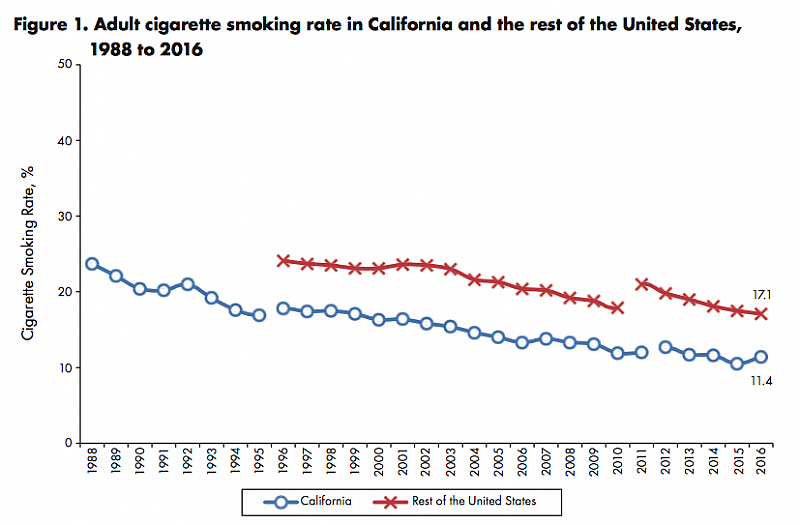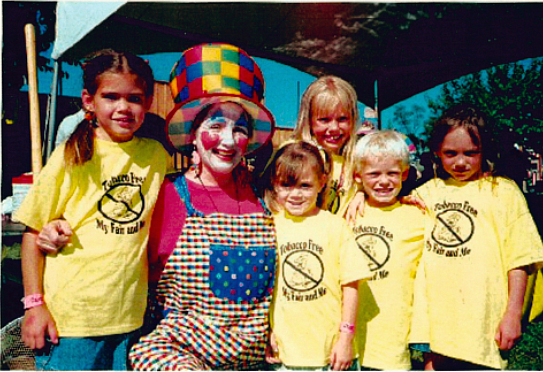Early childhood advocates see cannabis challenges rise as tobacco sales fall
The story was produced as a project for USC Annenberg's 2018 National Fellowship.
Other stories in this series include:
How filmmaker Rob Reiner put early childhood in the limelight
What did California's novel approach to funding early-childhood programs achieve?
As revenue declines from one 'sin tax,' California considers tapping another for children's programs
One California county epitomizes positive impact of home visiting amid national trend
More California school administrators gain skills as early-childhood leaders
How do you tell the story of a huge early childhood program over time?

This article is part of a series about First 5 — a tobacco tax initiative in California passed by voters 20 years ago to fund services for young children, from birth to kindergarten age. The series is supported by a University of Southern California 2018 Center for Health Journalism fellowship.
As more states consider legalizing marijuana, California's First 5 agencies are on the forefront of educating the public about the impacts during pregnancy and in homes with young children.
Few states have been harder on smokers than California. It was the first in the country more than 20 years ago to ban smoking in all workplaces, including bars and restaurants. It has among the highest taxes on tobacco products, and it increased the legal age to buy tobacco products — including e-cigarettes — to 21.
And when voters passed Proposition 10 in 1998, they not only approved a 50-cent tax on tobacco products, but also created state- and county-level agencies — now called First 5 — charged with ensuring that more children grow up in smoke-free environments. Smoking habits became even more expensive to maintain when voters passed Proposition 56 in 2016, adding another $2-per-pack excise tax.
According to the California Department of Public Health (CDPH), the state saw an immediate drop in adults smoking in the year after Proposition 10 passed — from 17.5% to 16.3%, as well as a 21% decline in per capita cigarette consumption.
Even so, the executive directors of some of the 58 county-level First 5 commissions aren’t letting go of the anti-tobacco part of their work. And now, with recreational marijuana use legal in the state, First 5 directors say they face a new challenge in spreading information about unsafe marijuana use during pregnancy and the risks posed to young children with access to edible forms of cannabis — a shifting landscape that other states considering the legalization of marijuana use beyond medicinal purposes will likely face.
Multiple prevention efforts
In 2001, First 5 California, the statewide organization created by a ballot initiative, began co-funding the California Smoker’s Helpline as a way to “expand service to focus on pregnant smokers, smoking parents and caregivers of children ages zero to five,” Erin Gabel, First 5 California’s deputy director of external and governmental affairs, said in an email. Helpline counselors provide services in English, Spanish, Mandarin, Cantonese, Korean and Vietnamese.
First 5’s contribution of $14 million in 2016-17, according to its most recent annual report, paid for services for 4,578 participants, including 226 pregnant smokers and 4,352 parents or caregivers of children five years or younger who were using tobacco. A randomized controlled trial of the intervention, published in the American Journal of Preventive Medicine, showed that pregnant women who received telephone counseling were more likely than those in the control group to quit smoking during pregnancy and to keep abstaining after their babies were born.
“Wide adoption of this intervention could help reduce the rate of maternal smoking and prevent its devastating health consequences,” the researchers wrote.
First 5’s anti-smoking efforts also include training pediatric care providers to screen young children for exposure to secondhand smoke and to refer parents who smoke for help.
While smoking has declined nationwide, California has the second-lowest rate of adult cigarette use in the nation, according to the Centers for Disease Control and Prevention. And since 2007, the number of births in California to mothers who smoked during pregnancy has dropped steadily each year, from 15,275 to 7,741 in 2016.
Tobacco use in California, compared with the U.S. as a whole. Credit: "California Tobacco Facts and Figures 2018," California Department of Public Health
Preventing use among future parents
Nina Machado, now executive director of First 5 Amador County in the Sierra Nevada region of the state, previously worked for the county’s Tobacco Reduction Department, funded by the state’s first-ever tax on cigarettes in 1988. She said in an interview she has “remained a good partner” with the tobacco reduction agency, still sits on its board, and provided the agency a mini-grant to fund training for child-care providers on the dangers of young children’s exposure to secondhand and thirdhand smoke.
While First 5’s focus has largely been on preventing parents’ smoking, Machado also targets prevention messages to students. “I don’t want 13-year-olds starting, either,” she said. “Those are our next parents.”
Since 2001, she has worked with the local county fair organizers to have a "Tobacco-Free Kids Day" during the fair, a concept that spread to include seniors, as well. Local businesses sponsor the purchase of brightly colored T-shirts to promote the message.
In fact, according to the California Student Tobacco Survey, Amador is one of several counties in the state where teen tobacco use averages over 20% — well above the statewide average of 13.6%. And across California, as in other states, the problem isn’t so much smoking as it is vaping, which has reached "epidemic" levels across the country, according to the U.S. Food & Drug Administration (FDA).
Amador County children wearing their tobacco-free T-shirts at the county fair. (Photo: First 5 Amador County)
A new RAND Corp. study, which surveyed 2,000 California youth over a three-year period, also shows that adolescents who vape are more likely to start smoking and continue using both types of products over time.
"The proliferation of tobacco product categories, flavored products, and the evolution in tobacco marketing appear to be fueling teens switching from traditional cigarettes to a new generation of tobacco products," said CDPH's most recent report on tobacco control. "A rapid public health response to the evolving tobacco product marketplace is needed to prevent the next generation of youth from a lifelong addiction to nicotine."
Lani Schiff-Ross, executive director of First 5 San Joaquin — an area of the state where cigarette use among pregnant women is higher than in other regions in California — hasn’t been afraid to stand up to Juul, the popular e-cigarette brand, on social media, accusing Juul Labs of using flavored tobacco to entice youth. The FDA is investigating the San Francisco-based company and said on Sept. 12 that it, and other e-cigarette makers, had a 60-day period in which to show that they're trying to limit use among teens.
Cannabis information, too
First 5 San Joaquin has also developed informational materials about cannabis use during pregnancy and breastfeeding, and it is expanding them to include information on edibles. According to the state’s Maternal and Infant Health Assessment, an annual statewide survey of nearly 7,000 women who have had a recent live birth, roughly 4.2% of women reported using marijuana during their pregnancy.
“There is no known safe amount of marijuana use while pregnant,” states a fact sheet that is part of the Weed-Free Baby campaign. Schiff-Ross also plans to put together a toolkit so other First 5 commissions across the state can use the materials with their logos.
To Kelley Bruce, the founder and CEO of CannaMommy.org — a nonprofit that supports women's use of cannabis during pregnancy and childbirth as a natural alternative to pharmaceuticals — said the Weed-Free Baby message "means that there is no known harmful amount either."
Bruce lives in Humboldt County, in Northern California, and takes her two youngest children, a 7-month-old and a 2-year-old, to First 5-funded playgroups that are partially supported with a county tax on marijuana cultivation. She has contacted Schiff-Ross about the campaign, and said in an interview that she would like to work with First 5 on "creating an environment for information to be exchanged and validated" and informing pregnant women what they can expect if they use cannabis.
"If our organization works with First 5 to produce some kind of educational series, that would be an amazing first step," Bruce said. "It's legal now. We can ignore it or we can be pioneers and do something awesome. It's a unique opportunity to show not just the state, but the rest of the country, how can you roll out a program that is informational and is successful and works."
Schiff-Ross said she's open to a relationship with CannaMommy. "Our goal is not to run around and say, 'We're not going to work with you,'" she said, but added that the campaign is being paid for with funds specifically devoted to substance use prevention efforts.
Many early-childhood advocates and First 5 leaders are hoping that statewide marijuana tax revenue will be directed toward early intervention efforts, as counties such as Humboldt and others are already doing. But Machado says she's concerned about the impact of legalization on families with young children, noting reports of emergency room visits and child abuse cases involving toddlers that have consumed edible marijuana. Other states that have legalized recreational marijuana use are seeing similar incidents — and not just among young children.
"I don’t think policymakers give enough thought to the ramifications of some of these things," Machado said.
[This story was originally published by Education Dive.]

